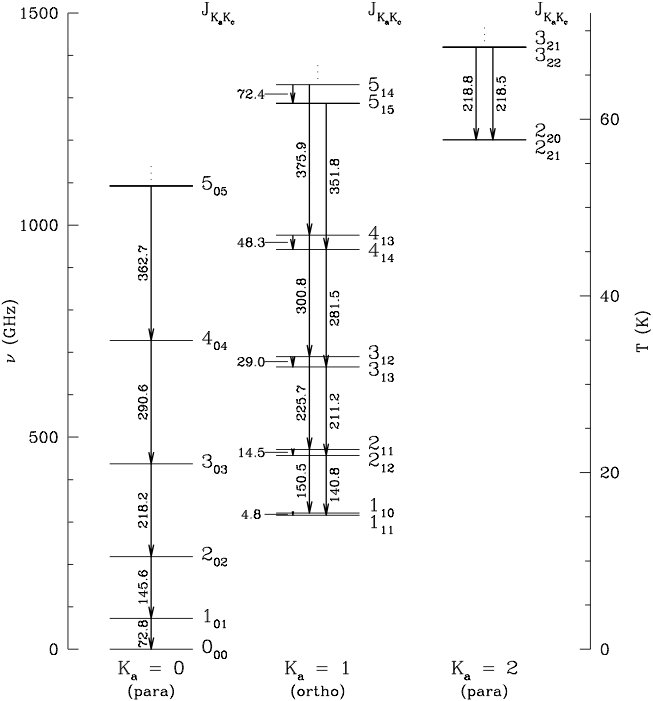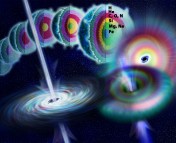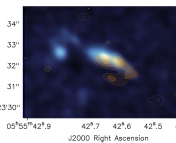Title: Formaldehyde Silhouettes Against the Cosmic Microwave Background: A Mass-Limited, Distance-Independent, Extinction-Free Tracer of Star Formation Across the Epoch of Galaxy Evolution
Authors: Jeremy Darling and Benjamin Zeiger
Authors’ Institution: University of Colorado, Boulder
Studying the history of star formation in the Universe is big business, researched by groups all over the world, and more than one astrobite has dealt with the same issue. Now, a group led by researchers at the University of Colorado, Boulder, have proposed looking for sites of star formation by observing their absorption signatures in the CMB. But how does it all work?
One of the biggest challenges in astronomy is relating observable quantities like flux density to physical quantities that tell us something about the environment where the photons were emitted. In terms of understanding when and where stars were formed in the Universe’s past, this challenge manifests in a number of ways, which vary depending on whether we are trying to observe star formation in our Galaxy or in distant galaxies. Direct observations of star formation in the Milky Way, where we could ostensibly resolve protostellar regions, are difficult (see this astrobite), but we can find young stellar aggregates after they’ve been formed by looking for bright O and B stars and their associated HII regions. When we see these hot, massive stars, we know they must be relatively young, because their lifetimes are short compared to cosmic timescales. Observations of star formation in the high-redshift Universe rely on this principle too, but instead of looking for individual OB associations or HII regions, astronomers use spectral features to determine if they are present in a given galaxy (e.g., UV continuum and H-alpha line emission). Essentially, these techniques try to probe star formation by looking for the products of star formation, but you could also imagine looking for the raw material that will eventually collapse to form stars: cool, dense molecular gas clouds.
Gas clouds which will eventually form stars are composed primarily of molecular hydrogen (H2), but we have to rely on observations of trace molecules like carbon monoxide (CO) or formaldehyde (H2CO) to study them, because those molecules are more easily detected, despite being only a fraction of the gas present in the clouds. The reason for this has been discussed before and really boils down to the relative ease with which we observe the molecular transitions of these trace molecules compared to molecular transitions of H2.

Figure 1: A line diagram for the rotational transitions of formaldehyde, showing the spacing of the various energy levels.
Here, a brief review of “molecular transitions” might be helpful to understand what’s going on. Because of the added complexity of their structure, all molecules can undergo vibrational and rotational transitions in addition to the familiar electronic transitions we see in atoms. In other words, when a molecule suddenly changes axes of rotation, a photon is emitted with energy equal to the difference in energy between the two rotational states (see Figure 1, for formaldehyde). The relative populations of two different rotational states can be described by an excitation temperature, which is the temperature we would expect if the excitation were produced by a Boltzmann (thermal) distribution of particles. For gas in local thermodynamic equilibrium (LTE), the excitation temperature equals the kinetic (i.e., thermal) temperature of the gas, but for systems not in LTE, the excitation temperature has no special physical meaning.
In the case of formaldehyde, collisions with H2 molecules in the surrounding gas can knock formaldehyde molecules into lower rotational energy states, creating an “anti-inversion” where the excitation temperature of the formaldehyde molecules is lower than the kinetic temperature of the gas (“inversion“, where the upper level is over-populated with respect to thermal, is what allows for stimulated emission in lasers and astrophysical masers). When “collisional pumping” by H2 drives the excitation temperature below the temperature of the cosmic microwave background (CMB), CMB photons can be absorbed by formaldehyde molecules in the over-populated lower energy state. Observations of this phenomenon could be a powerful probe of molecular gas in the Universe, because the strength of the absorption is modulated only by the amount of absorbing material and does not depend on the distance of the absorber from us, unlike observations of emission from molecular gas probes like CO. In addition, because the CMB illuminates the entire sky, the absorption of CMB photons by intervening formaldehyde molecules could potentially be seen in any direction!
Jeremy Darling and Ben Zeiger explore this idea of using formaldehyde to trace molecular gas in their paper posted to the arXiv earlier this month. Using a 1D, non-LTE radiative transfer code called RADEX, the authors investigate the excitation of formaldehyde and the subsequent absorption of the CMB as a function of H2 number density, the kinetic temperature of the gas, and redshift, focusing on the lines at 6, 2, 1, 0.6, and 0.4 cm, which have the strongest signal. In particular, they calculate the temperature decrement ΔTObs which would be observed due to absorption by a molecular gas cloud.

Figure 2: Formaldehyde excitation vs. H2 number density. The top panel shows that a temperature decrement is observable for each of the five centimeter-wave formaldehyde lines across a large range in density, with the bottom two panels showing results for just the excitation temperature.
What they find is that the centimeter-wave formaldehyde lines are “cooled” below the CMB temperature over a large range in H2 number density (102 cm-3 < n(H2) < 105 cm-3) and is essentially independent of redshift, as shown in Figure 2. The latter result occurs because, even though the excitation temperature grows roughly linearly with redshift, the temperature of the CMB also increases as we look back in the past, such that TCMB = (1+z)2.73 K. Likewise, ΔTObs is unaffected by the kinetic temperature of the gas when it is exceeded by the local temperature of the CMB (at z > 1).
The authors note that their results support the use of formaldehyde as an efficient tracer of star formation across much of the history of the Universe, including the peak of galaxy assembly at z ~ 2-4. To take advantage of the effect, they propose obtaining a deep radio map of the sky in order to observe formaldehyde absorption in many star-forming galaxies at once. Creating this formaldehyde deep field (FDF) would require spatial resolution matched to the size of star-forming regions in galaxies, enough bandwidth to cover multiple formaldehyde lines and a range of possible redshifts, and sufficient spectral resolution to see structure in the individual absorption lines. Number densities determined using the observed line ratios could be coupled with column densities from individual absorption lines to measure the line-of-sight physical size of molecular gas regions.
There are, of course, uncertainties in interpreting observations of an FDF, including the relatively poor calibration of the ratio of formaldehyde to H2 in molecular gas as a function of redshift. Furthermore, this method relies heavily on radiative transfer modeling to understand the physical processes modulating the shape and depth of the observed absorption lines. Regardless of these difficulties, however, observations of a formaldehyde deep field offer the astronomical community the opportunity to obtain a mass-limited census of star formation regions in an independent way from previous surveys. Those results could then be used in conjunction with existing observations using other methods to constrain our understanding of star formation across cosmic time.





Great post, Allison!